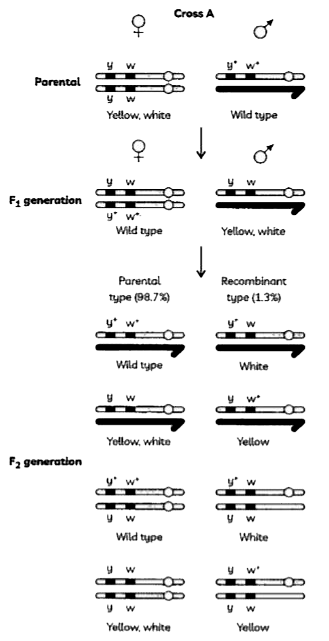Given below is a dihybrid cross performed on Drosophila

Which of the following conclusions can be drawn on the basis of this cross?
When yellow bodied (y), white eyed (w) Drosophila females were hybridized with brown bodied (y+), red eyed males (w+) and F1 progenies were intercrossed. F2 generation would have shown the following ratio:
1:2:1 because of linkage of genes
9:3:3:1 because of recombination of genes
Deviation from 9:3:3:1 ratio because of segregation of genes
Deviation from 9:3:3:1 ratio because of linkage of genes
The correct Answer is:D
The deviation can be easily explained by the phenomenon of crossing over or linkage. In Drosophila, several dihybrid crosses were carried out by Morgan to study the genes that were sex linked (genes present on the X-chromosome).
He found out that the genes were located on the X-chromosome.
They made observations that when the two genes in a dihybrid cross were located on the same chromosome, the proportion of parental gene combinations were much higher than the non-parental type. Morgan and his group also observed and stated that even when the genes grouped on the same chromosome, some genes were very tightly linked, they showed very low recombination frequency (strong linkage). Whereas the genes that were loosely linked showed higher recombination frequency (weak linkage).
Related Playlists
- BOOK - EDUCART PUBLICATIONCHAPTER - SAMPLE PAPER 1 EXERCISE - SECTION-B24videos
SAMPLE PAPER 1
- BOOK - EDUCART PUBLICATIONCHAPTER - SAMPLE PAPER (SELF-ASSESSMENT)-11EXERCISE - SECTION -C1videos
SAMPLE PAPER (SELF-ASSESSMENT)-11
- BOOK - EDUCART PUBLICATIONCHAPTER - SAMPLE PAPER 10EXERCISE - SECTION-C10videos
SAMPLE PAPER 10
Similar Questions
How many non-parental gene combinations were obtained when Morgan crossed yellow bodied, white eyed female to brown bodied, red eyed male ?
View SolutionHow many non-parental gene combinations were obtained when Morgan crossed yellow bodies, white eyed female to brown bodied, red eyed male ?
View SolutionIf yellow body,white eyed Drosophila is crossed with wild brown body red eyes Drosophila.Then what would be the frequency of recombinants in "F_(1)" generation?
View SolutionAssertion : When yelow bodied, white eyed Drosophila females were hybridised with brown-bodied, red eyeed males , and F1 progeny was intercrossed, F2 ratio deviated from 9:3:3:1
Reason : When two genes in a dihybrid are on same chromosome, the proportion of parental gene combinations are much higher than the non-parental typeView SolutionAssertion : When yelow bodied, white eyed Drosophila females were hybridised with brown-bodied, red eyeed males , and F1 progeny was intercrossed, F2 ratio deviated from 9:3:3:1
Reason : When two genes in a dihybrid are on same chromosome, the proportion of parental gene combinations are much higher than the non-parental typeView SolutionAssertion: Morgan carried out several dihybrid crosses in Drosophila to study genes that were sex linked.
Reason : Morgan hybridised yellow bodied, white-eyed males to brown bodied, red eyed females and intercrossed their F1 progeny.View SolutionMorgan (1910) made the following crosses in Drosophila. Write the results of these crosses in F1 generation.
(a) The white eyed male was crossed with red eyed female.
(b) The females of F1 generation were crossed with white eyed males.
(c) White eyed females were crossed with red eyed males.View SolutionA white eyed and long winged male Drosophila was scrossed to a viestigial winged (recessive) red eyed female .The two characters are linked in this anmla .When a female F1 was crossed the F2 generation produced
View SolutionA white eyed and long winged male Drosophila was crossed to a vestigial winged (recessive) red eyed female .The two characters are linked in this anmla .When a female F1 was crossed the F2 generation produced
View SolutionIn a dihybrid cross, white eyed, yellow bodied female Drosophila was crossed with red eyed, brown bodied male Drosophila. The cross produced 1⋅3 percent recombinants and 98⋅7 progeny with parental type combinations in the F2 generation. Analyze the above observation and compare with the Mendelian dihybrid cross.
View Solution

